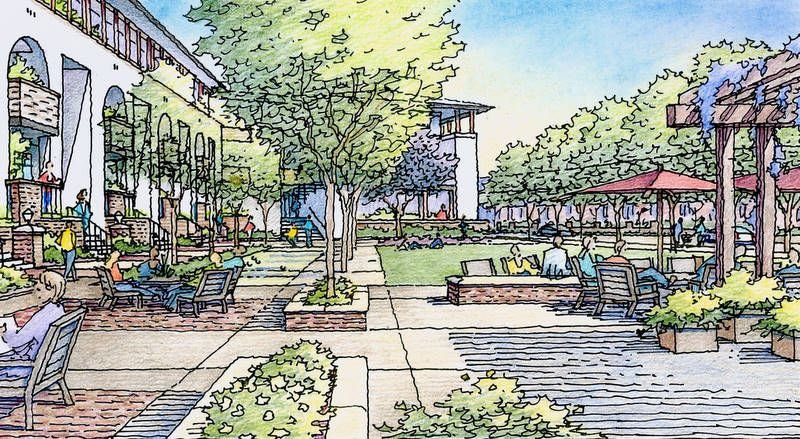Urban design is concerned with the arrangement, appearance and function of our suburbs, towns and cities. It is both a process and an outcome of creating localities in which people live, engage with each other, and the physical place around them.

The urban design includes various principles, namely planning, architecture, development, landscape architecture, engineering, economics, law and finance, among others. It operates and different phases and scales, from the macro scale of the urban stature (planning, zoning, transport and infrastructure networks) to the micro-scale of street furniture and lighting. When fully integrated into the policy and planning system, it can be used to inform the land-use planning, landform use, infrastructure and also the socio-demographic mix of the city or place.
The urban design also largely impacts and guides the economic, environmental, social and cultural outcome of a place:
- The economic and socio-economic composition of the society is affected- by its encouragement to local businesses and entrepreneurship, the desire of people to live there, the job opportunities, affordable housing and travel and the services and facilities made easily available.
- The determination of the physical space, ambience and space of a place by the connection of natural and built forms integrating within which infrastructure and individual buildings are sited. It affects the balance between the natural ecosystems and the built environment, also affecting its sustainability outcomes.
- The influence on health and socio-cultural aspects of society- how people interact with each other, move around, use the place and maintain it.
Although the urban design seems like a specific project, it is, in fact, a long-term process that continues to effects and evolves with time. Its various layers of individual buildings and infrastructure types, natural ecosystems, communities and cultures merge and gives the place a unique characteristic and identity.
ELEMENTS OF URBAN DESIGN
Here is a diagram for the clearer understanding of the hierarchical relation of the elements from macro to micro.

URBAN STRUCTURE
It is the overall framework of a region, town or precinct, showcasing the relations between built, unbuilt, natural ecosystems, activities and open space. Also takes into consideration the infrastructure and the transport networks.
URBAN GRAIN
It is the correlation of open spaces with built form, and the nature or extent of subdividing an area into smaller parcels or blocks.
DENSITY + MIX
It is the intensity of development and the ranges of land uses (residential, commercial, mixed, institutional and recreational)
HEIGHT + MASSING
It includes the scale of building about the height and floor area; how they relate to surrounding landforms, buildings and streets; building envelope, site coverage and solar orientation. It overlooks the sense of openness and enclosure.
STREETSCAPE + LANDSCAPE
The design of public spaces such as streets, open spaces and pathways and includes landscaping, microclimate, shading and planting.
FAÇADE + INTERFACE
It includes the relation of the building with the street, site and neighbouring buildings (alignment, setbacks, boundary) and the architectural expression of its façade (projections, openings, fenestrations, fins, patterns and materials)
DETAILS + MATERIALS
It includes the appearance of surfaces, objects and selection of materials in terms of craftsmanship, texture, colour, durability, treatment, sustainability, human comfort, safety and enjoyment.
PUBLIC REALM
Much of the urban design revolves around the design, management and development of publicly used spaces (public domain or realm) and how they are experienced, used and acknowledged.
TOPOGRAPHY, LANDSCAPE AND ENVIRONMENT
The natural environment includes the topography of landforms, watercourses, flora and fauna—whether natural or introduced. It may be in the form of rivers and creeks, lakes, bushland, parks and recreational facilities, streetscapes or private gardens, and is often referred to as ‘green infrastructure’.
SOCIAL + ECONOMIC FABRIC
It refers to the non- physical aspects of the urban form which includes social forms (culture, health, well- being), productive capacity, economic prosperity, demographics, life stages, social interaction, and support networks.
SCALE
It refers to the size, bulk and perception of the buildings and spaces.
URBAN FORM
It is the arrangement of the built-up area. This arrangement is made up of many components including how close buildings and uses are together; what uses are located where; and how much of the natural environment is a part of the built-up area.
PRINCIPLES OF URBAN DESIGN
Urban Design is identified by seven essential design qualities that create the quality urban design: The Seven C’s. They are Context, Character, Choice, Connections, Creativity, Custodianship and Collaboration. These are a series and combination of design processes and outcomes.
The seven C’s:
- provide a checklist of qualities that contribute to quality urban design
- are based on sound urban design principles recognised and demonstrated throughout the world.
- explain the qualities in simple language, providing a common basis for discussing urban issues and objectives.
- provide core concepts to use in urban design projects and policies,
- can be adapted for use in towns and cities worldwide.
AIMS OF URBAN DESIGN

Urban design is a process that puts in a lot of thought into every aspect of planning and wellbeing before it derives and produces a prototype. It provides the cities with a higher scope for growth, development and progress. So yes, urban design solutions are surely shaping up to our cities, for a better world.


